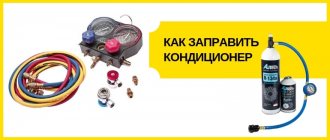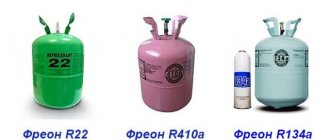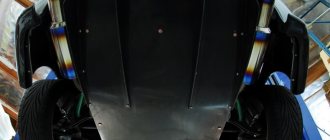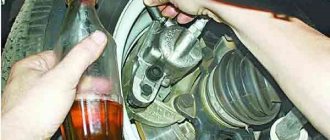Many car owners are interested in when to refill the air conditioning in their car? The answer to this question is quite simple. If there is still little freon – it’s time to refill the car air conditioner. To save extra money, you can do it yourself.
But how exactly do you refill the air conditioner yourself? What tools will be needed for this? And what rules should you remember? These issues will be discussed below.
Purpose and advantage
A car air conditioner is an indispensable assistant in the summer, when the temperature outside the window exceeds 30 degrees.
The wide-open windows and sunroof in the car only play the role of a fan and simply drive hot air around the cabin.
In turn, the climate system works on a different principle and performs a number of useful functions:
- reduces the air temperature to the temperature required by the car enthusiast;
- effectively combats “sweating” of glass (this can be useful in winter);
- maintains humidity levels at optimal levels;
- reliably protects the car interior from the ingress of unpleasant odors and burnt gasoline vapors;
- is a very powerful filter for air inside the cabin;
- you don’t need to open the windows - the cooling and cleaning system will do everything itself.
Car air conditioning is an option that is never superfluous. If desired, the device can be installed in almost any car (even if it is not included in your configuration).
How to refill a car air conditioner: a guide to action
Direct charging of the car air conditioner using a pressure gauge is carried out as follows:
- Remove the cap from the low pressure line, having previously cleaned the area around it. Please note that even a few particles of dirt entering the air cooling system can cause compressor failure;
- Place the filling hose onto the fitting;
- Turn on the engine and increase the speed to one and a half thousand;
- Turn the air recirculation to maximum by opening the low pressure valve and turning the refrigerant bottle with the tap facing down. Slowly open the tap without turning off the car engine;
- Monitor your blood pressure readings. The meter should not read more than 285 aPa;
- Close the valve as soon as the air temperature from the blowers approaches 7 degrees. Celsius.
Stare at the window of the filter drier. If there are no bubbles in the clear liquid, then the process is completed successfully. If you do not understand how to charge a car air conditioner with your own hands, the video of the process at the end of the article will help you understand the details.
Principle of operation
A car air conditioner consists of several elements:
- A compressor that ensures constant circulation of freon throughout the cooling system circuit;
- Condenser - heat exchanger. In this unit, freon vapor accumulates and condenses with further heat release;
- An evaporator acting as a heat exchanger. It is in it that the evaporation of liquid freon and the removal of heat occurs;
- Receiver-dryer, through which the refrigerant is cleaned and dried;
- Pipelines;
- Expansion valve;
- Cooling fan;
- Automation systems (fuses, sensors, etc.).
Essentially, a car air conditioner has three main elements - a compressor, an evaporator and a condenser. All other details play a supporting role.
The system works according to the following principle.
Freon is in a closed circuit. Under the action of the compressor, the refrigerant is heated and sent further through the system under pressure.
On its way there is a condenser, where the refrigerant is cooled and converted into liquefied gas.
After this, the freon enters the receiver-dryer, which filters out dirt and debris.
The refrigerant then passes through numerous pipes in the system and flows to the expansion valve.
After cooling, the freon is sent to the evaporator (located directly inside the car) and enters the passenger compartment. The refrigerant is then sent to the compressor.
That's it - the cycle is closed. By the way, in addition to its cooling function, the evaporator also effectively dehumidifies the air.
The main reasons for refueling
Many car enthusiasts do not know when to refill their car air conditioner and remember this only when the device fails. But here it is important to consider several options.
Natural leak.
Freon is in a closed circuit, but even this does not save it from a small leak. It is believed that up to 10-15% of the refrigerant leaves the system over the course of a year.
Consequently, most modern cars require refueling after three years, and older models even earlier - after 1-2 years.
System malfunction.
If the refrigerant leak exceeds 15-20% per year, then we can safely say that the system is faulty.
The reasons may be the following:
- leakage in pipeline systems due to increased vibration (for example, reduced efficiency of gaskets);
- presence of mechanical damage (holes, cracks) on pipes or main components of the system;
- the appearance of corrosion directly in the capacitor itself (this phenomenon occurs very often).
How often do you refill your car air conditioner?
The standard amount of freon loss in a car air conditioner over one year is up to 15%. Therefore, every 3 years, to prevent depressurization of the circuit, refilling the car air conditioner is required. If your vehicle left the assembly line a long time ago, it is recommended to carry out the procedure more often. The same is true if your cooling system is constantly running.
Leak detection methods
Today there are several main ways to quickly find a leak in a car air conditioner.
Let's look at the most popular of them.
Using a leak detector.
Such a modern device provides real assistance in finding a leak when it is not possible to visually find the problem.
The advantage of the product is high sensitivity and accuracy. But the leak detector has a drawback. If the damage is small, then it will not be possible to find it this way.
Nitrogen filling.
This technique is as old as the world, but is still actively used today to check car air conditioning. Its essence comes down to filling the system with nitrogen under high pressure.
In this case, the location of the freon leak is determined solely by ear. The advantage of this method is simplicity and accessibility. Disadvantage: low efficiency.
Soap solution.
To simplify the search process, a soap solution is often used. But it's dangerous. The air conditioning system contains not only freon, but also oil to lubricate the compressor.
The latter is capable of absorbing moisture well and can only be combined with a specific type of freon.
The use of a soap composition often leads to compressor breakdown and, as a result, serious waste.
Application of ultraviolet additive.
Modern and most effective method for leak detection. It is actively used by employees of almost all modern service stations. The point is simple.
In the process of filling the car air conditioner with freon, a little special additive is added to the composition.
The latter mixes with the contents of the system (refrigerant, oil) and when released outside (at the leak) becomes green.
The advantage of this method is clarity (the location of damage in the system is immediately visible) and absolute safety for the system. The downside is the high cost.
Freon selection
A professional service station with qualified personnel can be used to recharge the car's air conditioner. Although many drivers want to maintain their car themselves. Solving such problems may require different types of tools. But in all cases it is necessary to purchase the refrigerant itself. Previously, all cars used R12 freon refill. This composition contained fluorine and was very productive. Efficiency indicators are even higher than modern solutions. The only problem with R12 is the fact of the increased harmfulness of the refrigerant. Due to the identified problems that the composition leads to, in 1992 it was decided to completely abandon its use. R12 was officially banned.
All motorists who own vehicles manufactured in 1992 have switched to the new R134a composition. And owners of old cars were forced to buy and refill the old mixture themselves, or switch to an updated type of freon. All gas stations were officially ordered to completely eliminate freon containing chlorine and fluorine.
When selecting the composition for each specific air conditioning system on your car, you can simply lift the hood and look at the appropriate plate. It indicates what refrigerant is used here. But it is difficult to confuse the systems, since the filling fittings used, in addition to other differences, are completely different. Thus, on the new type of refrigerant pipes, the fitting was higher and had a larger diameter. There are stickers in the engine compartment of cars indicating the type and rate of refilling of the car air conditioner.
Required quantity
Also, motorists do not always understand exactly how much refrigerant they need to refill the air conditioner. After all, it doesn’t make sense to buy an excessive amount, since you will spend extra money and not use the freon itself. The pleasure is not the cheapest, so it is recommended to first accurately calculate the required filling volume. In the best case, the car has a special plate under the hood indicating the type, norm and required amount of the substance. But not everyone is so lucky, since some cars do not have a plate for one reason or another.
If there are no recommendations from the manufacturer under the hood, you should seek help from an authorized dealer or the machine’s operating manual. Such information is necessarily duplicated there. For Russian cars, the norm for most refilled air conditioners is considered to be from 600 to 900 grams. Although sometimes absolute accuracy does not play a big role, since refueling and partial filling of the air conditioning system with refrigerant are carried out independently. The air conditioner can be filled with freon:
- at a factory during the production of a car;
- after renovation;
- as part of scheduled maintenance, etc.
https://www.youtube.com/watch?v=wCsNxUKktTU
After repairs and at the factory, when the system is empty, it is fully charged. But as part of scheduled maintenance, only refueling is carried out, which is why it is only possible to fill the air conditioner to normal. Only in this state will the unit be able to operate at full capacity. Partial refilling is problematic because we cannot know exactly how much freon is left inside the system. For this reason, refueling is carried out by monitoring the pressure on the pressure gauge. So if you were unable to find out the exact numbers and determine the amount of refrigerant required, then just start from the arrow of the measuring device.
Using oil when refueling
If you look carefully at the table for the amount of refrigerant in the air conditioning unit, you will see the value and oil standards there. At the same time, not everyone knows the nuances of refilling it and the reasons for its use. Some car owners, when filling the air conditioner in their car with their own hands, always recommend adding oil. But in fact, if there is an excess amount of lubricant, breakdowns of the piston compressor occur. This is due to the fact that when oil passes through the unit along with the refrigerant, carbon deposits appear on the components. And it’s not entirely clear how to act in such a situation.
But experts give simple and clear advice. When refilling the air conditioner in a car, use freon, which already contains a certain amount of oil. The manufacturer indicates the relevant information on the packaging of the can. Everything there is strictly dosed, so you can’t overdo it with oil or add too little. Be sure to read the owner's manual specific to your car. The thing is that some cars require separate refilling of freon and oil. Then so-called polyalkylene glycol oils, abbreviated PAG, are used. In this case, oil will need to be poured into the compressor using the appropriate inlet in the crankcase.
Vacuuming
In addition to the procedure for refilling freon and pouring oil into the system, many people overlook such a significant operation as vacuumization or evacuation of the air conditioner. It is almost impossible to avoid the penetration of air and moisture into the car air conditioning system if less than 50% freon remains inside it. Yes, the equipment will continue to operate, although it will not be able to operate at full capacity. The probability of compressor failure and the formation of rust (corrosion) on the tubes of the unit is too high. If you miss this point, expensive repairs will be required. It will cost significantly more than conventional vacuuming. To remove accumulated air and moisture from the system, you will need to use a vacuum pump.
To vacuum the air conditioner yourself, you need to follow a certain sequence of procedures and actions:
- Turn on the car heater and warm up the car. This will allow moisture to condense in the evaporator.
- Connect a vacuum pump to the compressor connection. Now unscrew the nipple and turn the tap under it. You need to turn it counterclockwise.
- Turn on the pump. Let it run for 15 minutes. When the required time has passed, tighten the valves and turn off the pump.
- Step by step this procedure should be repeated several times.
When you finish vacuuming, be sure to wait a few hours. There is no need to wait more than 4 hours. Only after this is it possible to start refilling the car air conditioner.
Repairing the leak
If the damage is significant or an entire system unit has failed, then it is better to contact professionals for repairs.
But most often the damage to the air conditioner is minor. Therefore, you can carry out restoration work yourself.
There are two options here.
Using a special patch.
Here the sequence is as follows:
- prepare a small metal tube that fits the diameter;
- place small clamps on it, clean it with sandpaper and degrease it with an alcohol solution;
- connect the two halves of the coupling using regular electrical tape;
- Apply glue to the prepared coupling, place the part in place and tighten it with clamps.
As an option.
Using sealant.
Today, special products are sold that effectively heal minor damage. All that is necessary is to pump them into the system along with freon.
After 20-30 minutes, the existing cracks will disappear, and the problem with freon leakage from the car air conditioner will be eliminated.
Air conditioner care
Now you know how to charge the air conditioner in a car with your own hands. In conclusion, let's talk about the rules of care :
- Wash the radiator at least once every 3 months, as dirt and dust constantly settle on it, which significantly reduces the efficiency of the device.
- In winter, you need to warm up the air conditioner at least once a month. To warm up, you need to drive the car into a warm place and turn on the cooling device for 15-30 minutes.
If leaks occur, contact a service center for repairs or repair the pipes yourself.
Watch the video yourself to see how to recharge the air conditioner in your car.
Preparatory work
Before refilling your car air conditioner, you must clearly determine the required type and volume of refrigerant. Everything is simple here.
If your car was manufactured before 1992, then you should use the R-12 type of freon.
Since 1993, car manufacturers have been pumping in R-134a freon. The reason is a banal ban on the use of R-12.
Difficulties may arise only for owners of cars produced in 1992-1993, because during the transition period, not all manufacturers immediately switched to R-134a.
To find out more accurate information, carefully study the sticker on the inside of the hood (this data is usually indicated there).
The second option is that you can recognize the type of freon by the fitting. In new models of car air conditioners that operate on R-134a, the fitting has a larger height and diameter.
As for the refrigerant charging standards, they are indicated on the plate that we talked about above.
In addition, this information can be obtained from a specialist or in the operating instructions.
On average, the norm for domestic cars is about 500-1000 grams.
Equipment
To refuel yourself you will need certain equipment:
- Metrological station.
- Hoses.
- Freon cylinder for connection.
- Adapter with tap for connecting the station.
There is also a special refilling kit, which includes a freon cylinder and a hose with a pressure gauge. It is quite enough to refuel the system.
All this is sold in many auto stores. The cost of this list can be 2000-2500 rubles (minimum). Of course, there are different stations and hoses, so the price may be higher. All this will cost more than refueling at a service station, but later you can use this system for subsequent refuelings, which, as you know, are often required.
Final check and troubleshooting
Now all that remains is to turn on the car air conditioner and check its operation. Here pay attention to the following points:
- make sure that within a few seconds after turning on the air conditioner, cold air begins to flow into the cabin;
- inspect the entire system for freon leaks;
- if you suspect a leak, you can re-check (we discussed the technology above);
- listen to the operation of the compressor; if there are extraneous noises, this may indicate wear of parts or internal damage to the unit. Often the cause of noise is a faulty bearing, as a result this can lead to failure and repair of the compressor;
- Clean air should come out of the system, without any unnecessary odor. Otherwise, replace the cabin filter.
Preventive measures
Long-term operation of the car air conditioner without problems or leaks indicates that the car owner carefully monitors the operation of his vehicle and all its systems. There are literally two useful recommendations for self-service of an air conditioner, which are aimed at increasing the service life of the system and maintaining its efficient operation. Car owners need:
- Periodically clean the radiator of your car air conditioner. The procedure for washing this element is not the most complicated, so there is no need to involve specialists in it.
- Use air conditioning in winter. In winter, there is no need to cool the interior. Here the entire emphasis is on heating. But to prevent the air conditioner from breaking down prematurely, it should be turned on in winter. To do this, it is recommended to go into any warm room at least once a month and turn on the interior cooling at medium speed for 10 - 20 minutes.
When there are no breakdowns or leaks in the car air conditioning system, refilling freon yourself is not so difficult. You can easily cope with the task yourself. But in order to carry out all operations correctly, you should study the design of the air conditioner in advance, understand the principle of its operation, select the appropriate refrigerant and acquire the necessary equipment.











